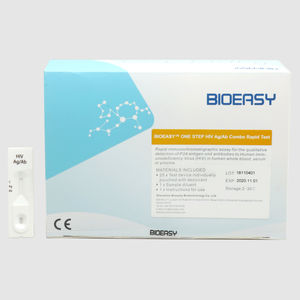
- Laboratory
- Laboratory medicine
- Rapid rotavirus test
- Bioeasy USA Inc.
Rapid gastrointestinal disease test for antigensadenovirusrotavirus
Add to favorites
Compare this product
Characteristics
- Applications
- for gastrointestinal diseases
- Tested parameter
- for antigens
- Micro-organism
- adenovirus, rotavirus, Helicobacter pylori, Salmonella
- Sample type
- stool, serum, plasma, whole blood
- Analysis mode
- immunochromatographic
- Format
- cassette, strip
Description
Colloidal gold immunochromatography
• Convenient and easy-to-understand
• Simple and safe specimen collection procedure
• Rapid and accurate test results
Helicobacter pylori is a Gram-negative, microaerophilic bacterium that lives in various areas of the stomach and duodenum. It can cause mild chronic inflammation oft he gastric mucosa, or even stomach and duodenal ulcers and stomach cancer. More than 80% of the original will not show signs.More than 50% of the world’s population has H. pylori in their upper gastrointestinal tracts.Infection is more common in developing countries.
Rota-Adeno
Rotavirus and Adenovirus are major causes of infectious gastroenteritis in infants and young children,also observed in adults. They are transmitted by fecal-oral contact. The main symptoms of viral gastroenteritis are watery diarrhoea and vomiting. The affected person may also have headache, fever,and abdominal cramps (“stomach ache”).ln general, the symptoms begin 1 to 2 days following infection with a virus that causes gastroenteritis and may last for 1 to 1 O days, depending on which virus causes the illness (Rotavirus 3 days and Adenovirus 5-8 days).
Typhoid
Typhoid fever is a bacterial disease,caused by Salmonella typhi. It is transmitted through the ingestion of food or drink contaminated by the faeces or urine of infected people. Symptoms usually develop 1 ~3 weeks after exposure, and may be mild or severe. They include high fever, malaise, headache, constipation or diarrhoea, rose-coloured spots on the chest, and enlarged spleen and liver.
Catalogs
No catalogs are available for this product.
See all of Bioeasy USA Inc.‘s catalogsRelated Searches
- Assay kit
- Blood assay kit
- Serum assay kit
- Immunoassay assay kit
- Plasma assay kit
- Infectious disease detection kit
- Blood rapid diagnostic test
- Rapid lateral flow test
- Immunoassay rapid diagnostic test
- Cassette rapid diagnostic test
- Rapid virus test
- Respiratory infection test kit
- Whole blood detection kit
- Serum rapid diagnostic test
- Plasma rapid diagnostic test
- Optical assay kit
- Clinical assay kit
- Whole blood rapid diagnostic test
- Cassette assay kit
- Fluorescence assay kit
*Prices are pre-tax. They exclude delivery charges and customs duties and do not include additional charges for installation or activation options. Prices are indicative only and may vary by country, with changes to the cost of raw materials and exchange rates.



